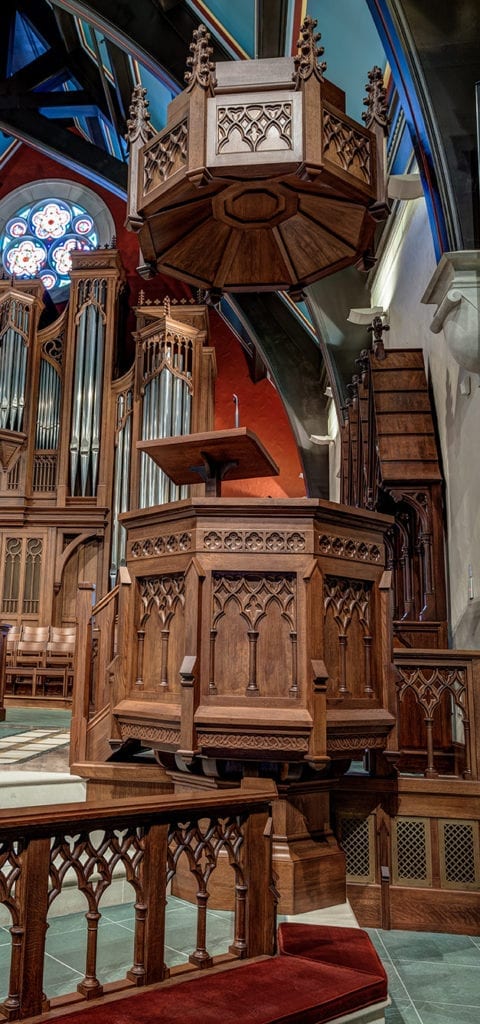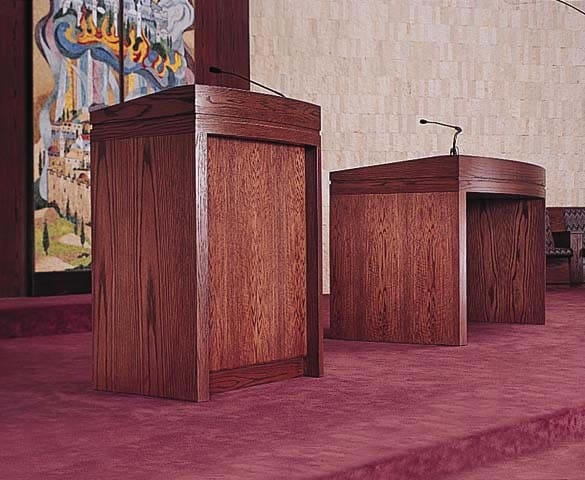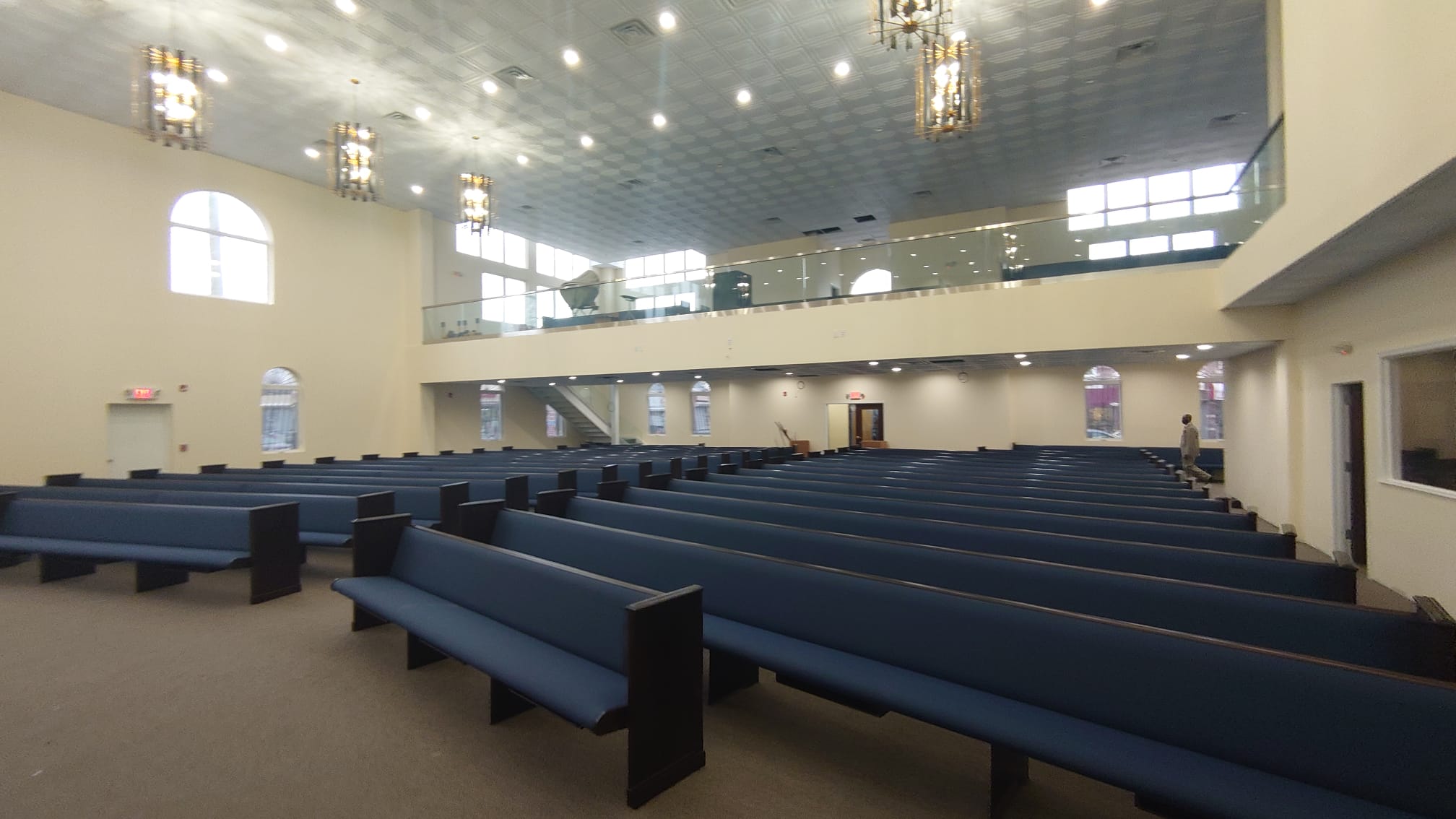
If you are renovating your church or building a new one, you may see confusing terminology. Some places may use words like lectern, podium, ambos, and Bimah furniture interchangeably, but there are differences in each. The difference may be whether you are in a Catholic church, a Protestant church, or a Synagogue. Other differences include standing on it, behind it, or in it. And if all this now sounds confusing, don’t worry!
Here at New Holland Church Furniture, we aim to help you get high-quality worship furniture for your church or synagogue. We know that may include ambos, podiums, or lecterns for churches or bimah tables for temples.
For more than 60 years, places of worship across North America, South America, Bermuda, and the Caribbean have trusted us to build them exceptional pieces of furniture to bring reverence and beauty to their worship space. Find a rep local to you today to see how we can help you get the furniture you need!

What Are Lecterns for Churches?
Lecterns for churches are raised, slanted stands typically used for holding a Bible or sermon notes. The term ‘lectern’ comes from the Latin word lectus, the past participle of the verb legere, which means “to read.” The word ‘lecture’ comes from the same Latin word, so when you hear someone talking about a lectern, you can think of someone lecturing behind a tall stand.
What Is the Difference Between a Podium and a Lectern?

On the other hand, a podium is a raised platform on which the speaker stands to give their sermon. The plural form of the word podium can either be podiums or podia. These terms come from the Greek word pothi, which means “foot.” The word ‘podiatrist’ also comes from the same Greek word, so you can remember that a podium is a platform on which you stand.
And while you stand on a podium, you’ll never find anyone standing on a lectern. Podium and lectern are often used interchangeably, especially at public speaking engagements. However, since a lectern is a tall stand with a slanted top, a public speaker or preacher would stand behind it rather than on it like a small platform on a stage or podium. This difference between a podium and a lectern is one that you need to know when renovating a church or other worship space.
Does your worship space need both a podium and a lectern? Sometimes. Most houses of worship include some sort of lectern for the clergy to place their notes for the services, so you likely have a need for a lectern. On the other hand, having a raised platform on which to speak without a lectern can make services more conversational and less like a classroom lecture. Some churches and synagogues have both. It depends on the atmosphere you want to evoke in your worship space, the space itself, and your goals for worship services. Need help deciding? Get in touch with one of our friendly reps for clarification and advice!
Is a Lectern Different Than a Pulpit?

Yes, lecterns for churches are different than pulpits. A pulpit is typically attached to the building and a raised structure. For example, in some churches, a pulpit may be an enclosed structure in which a pastor or other speaker may step in to give a reading from the Bible or preach.
As we noted before, a lectern is more of a tall stand that a speaker positions themselves behind. Lecterns for churches can sometimes be portable, whereas pulpits stay in one place since they are typically attached to the church. Pulpits surround the worship leader and elevate them above the congregation, while a lectern is in front of the speaker and doesn’t raise the speaker any higher.
How Do Ambos and Bimah Furniture Fit in?

Ambos are sort of like a cross between a pulpit and a lectern. They are typically an elevated platform like a pulpit but also include a slanted top like a lectern for reading scripture lessons. Ambos are freestanding, making them different than a pulpit, and some enclose the speaker, unlike a lectern. You’ll typically find ambos in Catholic or more liturgical congregations.
You’ll find Bimah furniture in Jewish houses of worship. The word ‘bimah’ is Hebrew for “platform.” It refers to both the platform in the synagogue and the reading table from which the Torah is read. Unlike churches, the reader stands in front of the Bimah so that their back is towards the audience and facing toward the front of the sanctuary.
Get High-Quality Podiums, Lecterns, Ambos, and Bimahs from New Holland Church Furniture!
Whether you’re looking for a more traditional look in your church, synagogue, or something more modern, New Holland Church Furniture can build more than just your straight or curved pews. We also have plenty of experience building Bimah furniture, ambos, pulpits, podiums, and lecterns for churches and synagogues. We use only the best wood and old-world craftsmanship to create your one-of-a-kind pieces.
Now that you understand the differences between a podium and lectern and what a pulpit, ambo, and Bimah furniture are, you can order the furniture you need confidently. If you’re still unsure which one you want, please speak with one of our friendly reps! They’ll help guide you through the process to determine which elements of worship furniture you need or want for your space.








